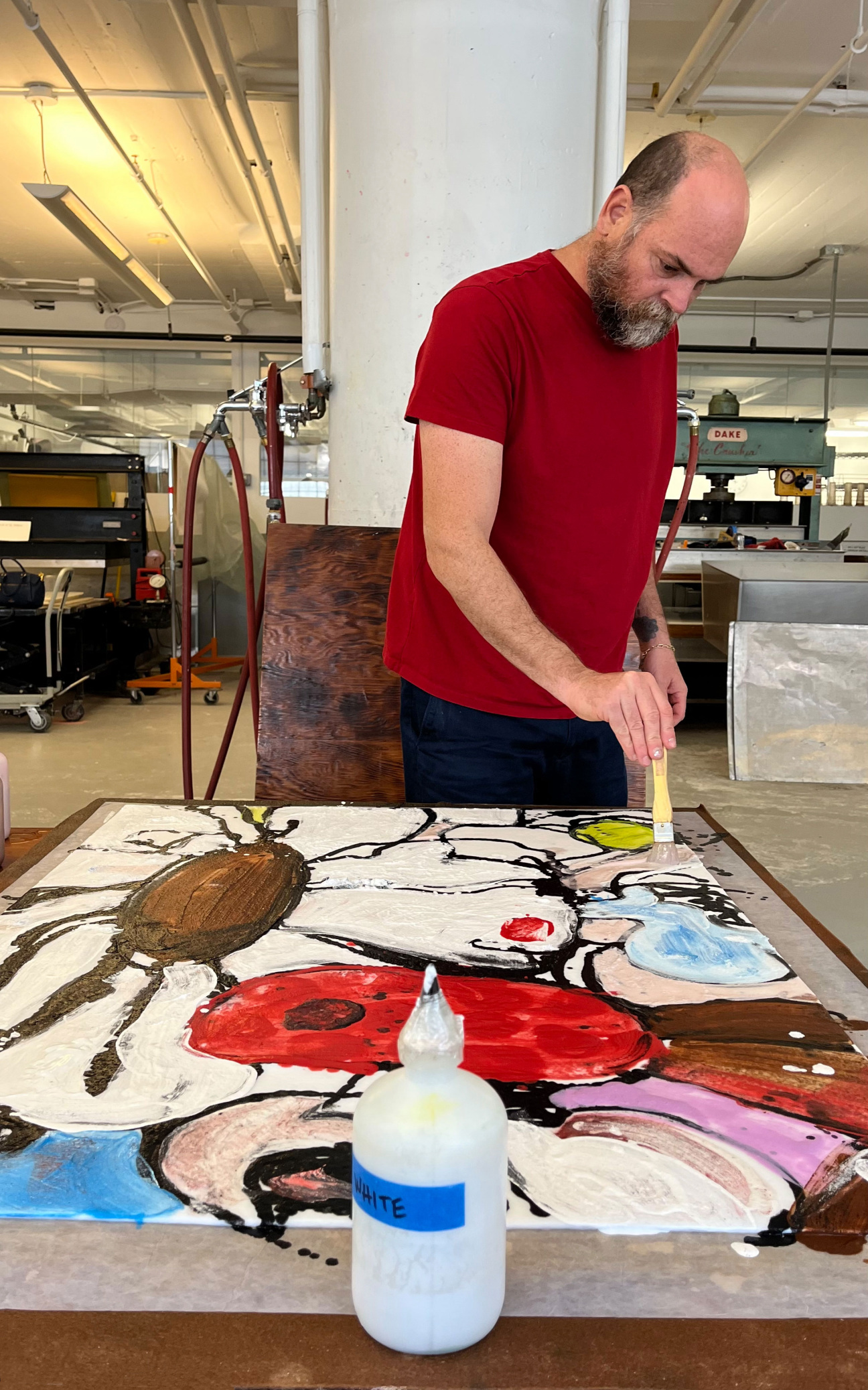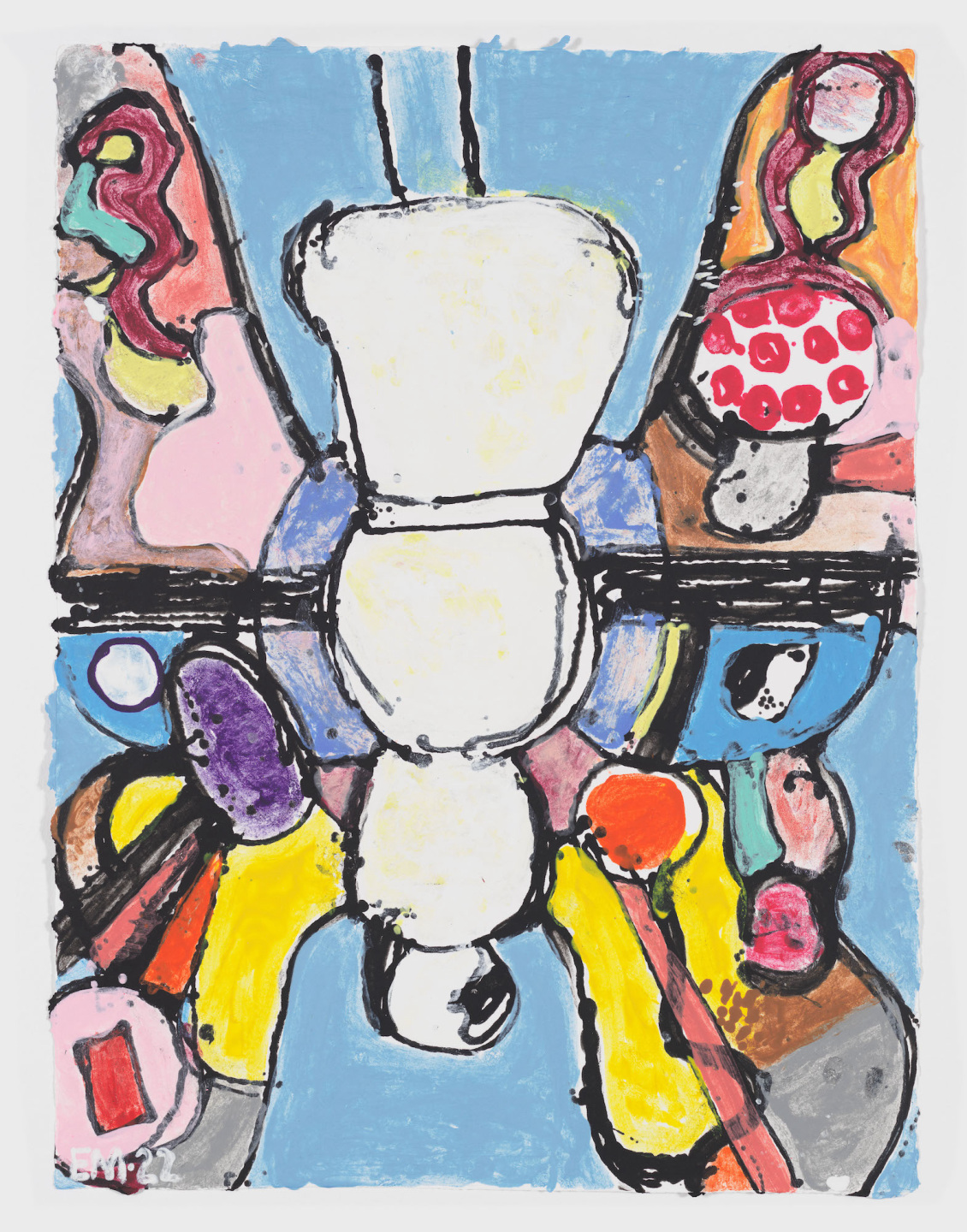From 20th-century master painters to contemporary icons, prominent Hamptons artist couples have long captivated the imagination: Elaine and Willem de Kooning, Jackson Pollock and Lee Krasner, Rashid Johnson and Sheree Hovsepian, April Gornik and Eric Fischl. This weekend, Eddie Martinez and Sam Moyer join the list of East End heavyweights when their pas de deux exhibit opens at the South Etna Montauk Foundation, founded in 2021 by Amalia Dayan and Adam Lindemann on the tip of Long Island’s South Fork. The show juxtaposes Moyer’s latest stone paintings—made from marble slabs and slate the artist sources from local quarries with a plaster underlay that references classic fresco and stucco walls—against Martinez’s recent paper-pulp works in his signature, electric language of abstract patterns and shapes, butterflies, flowers and mushrooms. Ahead of the show, the husband-and-wife talents reveal the secret to coexisting art practices.
Jacoba Urist: Both of you are presenting new works this weekend at South Etna Montauk Foundation. What was the inspiration for your pair of concrete backgammon boards in the show, Sam?
Sam Moyer: I started making these backgammon boards as a gift for Eddie, and then people saw them and really liked them, so I started producing the boards to raise money during the beginning of the pandemic. I put the proceeds of the first one I sold towards a local food pantry. I’ve been introducing them online and every time I sell one, the funds go to a nonprofit. But this will be the first time I’m showing them in public. The proceeds from the backgammon tables in this show will be donated to abortion advocacy groups—National Advocates for Pregnant Women and The Brigid Alliance.
Backgammon is a game in our family that’s a way for generations to interact. My dad taught me how to do it. Eddie will teach our son Arthur. It’s how to have a conversation: you play a game of backgammon. People will get to play on the boards during the show. I thought it would be fun to introduce them here because it’s Eddie and me showing together. The exhibition has a familial feel to it. It’s summertime and Montauk is a smaller community. The spirit of the space invites people to sit down and play backgammon and hang out.

JU: Eddie, the paper-pulp paintings you produced during your spring residency at Dieu-Donné in Brooklyn are on view. How are these works unique to your practice?
Eddie Martinez: It’s really interesting for me because this process is totally singular from other things that I do. If you’re making a print, you have a stone or a plate and that translates to the paper. If you’re making a painting, the paint goes on the paper. If you’re drawing, the marks go on the paper. But with this, the paper that you’re working on isn’t fully paper yet. It’s compressed pulp. So, you’re working on a wet sheet that’s pretty thick and then the paint is also pigmented pulp. It feels like painting, but then when it’s dried and pressed into a sheet, it all flattens out and you can’t see a distinction between any marks—there’s no sort of topography.
JU: It’s exciting for viewers to experience two married artists output side-by-side. How do you describe your creative life together?
SM: The fact that our work is so different always really helped us. We tend to be the first people we each go to when we need to push something, if our work needs more. And we turn to each other for really concrete “I need help” kind of questions. Also, we always maintain respect around each other’s practice. That’s why the floor plan at the South Etna Montauk Foundation seems very poetically aligned to two artists, where there’s two separate spaces, but a hallway connects them. Eddie and I always have separate studios and separate practices, but we always keep the line of communication between us. We’re not stepping on each other’s toes, but I know Eddie is there if I need him.





EM: We genuinely really like and respect each other’s art. I’m not a minimalist obviously, and I’ve never studied that kind of work, but what Sam does and what she's accomplished—the way she’s pushed things into such a painterly area now—is fascinating to me. And I know that she really likes my work. We are each other’s sounding board when we don’t get the immediate response that we are hoping for.
SM: I once had to completely remake a show after Eddie came by for a visit, and I’m really glad I did. But it was a hard day.
JU: How does the intimate space of South Etna influence the exhibit?
SM: It’s quite easy in your mind to imagine each person would take half the space and have the exact same layout. Everything is fair and equal. But I’m 99.9% sure that Eddie and I are going to mix everything up, and each space will have its own backgammon table in it to play. What’s so charming about this space is that it has a domestic feel to it—the windows, the light. It’s almost like when you see your work in a home versus seeing it in a gallery. You have more of a sense of what life is like, and that your work is going to continue on without you in some way. The space lends the idea of a more family-based invitation into a life.
EM: Knowing us, we operate in a similar way with installations. We’re just going to go there and do what feels right. That’s how we always do it when we are hanging our individual shows. There’s zero pressure for this weekend. It’s not a commercial venue. It should just be fun.










 in your life?
in your life?

